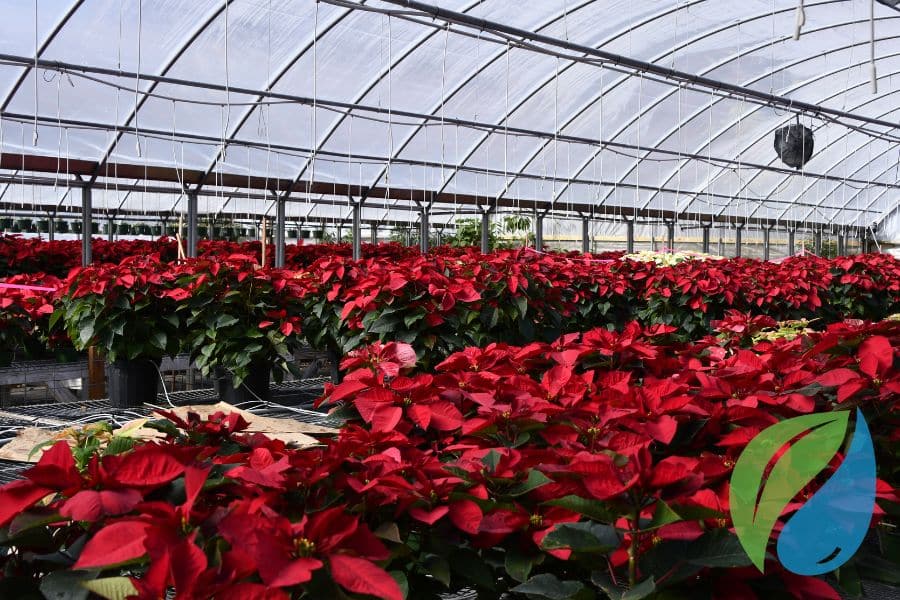Bacterial diseases can significantly impact the success of your growing season. Control bacterial diseases by following strict sanitation protocols that include preventative bactericide and fungicide applications with a broad-spectrum product like Phyton 27.
Common Bacterial Disease in Greenhouse Plants
Moist, hot conditions are generally conducive to bacterial disease. Several diseases often plague greenhouse plants, including Pseudomonas (bacterial leaf spot and bacterial blight), Xanthomonas (bacterial leaf spot), and Erwinia (bacterial wilt). Let’s take a closer look at each one.
Pseudomonas and Xanthomonas Bacterial Leaf Spot
Bacterial leaf spot is caused by two strains of bacteria: Pseudomonas and Xanthomonas. These bacteria cause small, water-soaked lesions on leaves that turn brown or black. Some may have a yellow halo. Spots can merge to cause large, necrotic areas and eventually defoliate and kill the plant.
Ornamental plants, lettuce, peppers, tomatoes, and cabbage are common host plants for bacterial leaf spot. The disease is spread by splashing water, contaminated tools, and infected plant debris.
Pseudomonas Bacterial Blight
Bacterial blight caused by the bacteria Pseudomonas also creates water-soaked lesions on leaves, but these lesions also extend to stems and flowers. As the lesions expand, leaves may appear scorched and tattered, and stems may develop brown or black streaks. Infected flowers may drop prematurely.
Ornamental plants, beans, tomatoes, cucumbers, and peppers are often host plants for bacterial blight. It spreads through splashed water, mechanical contact, and wounds or natural openings in the plant.
Erwinia Bacterial Wilt
Bacterial wilt is a disease often caused by the Erwinia bacteria. Infected plants will experience sudden wilting despite adequate soil moisture that starts in the lower leaves and moves up the plant. A bacterial ooze may release from cut stems.
Ornamental plants as well as tomatoes, peppers, eggplants, cucumbers, potatoes, and melons are all susceptible to bacterial wilt. It spreads through contaminated soil, irrigation water, and infected plant material and through wounds or natural openings in the plant.
Systemic Bacterial Control Protects Your Profits
Systemic bacterial control is the silver bullet to protect your plants and your profits this growing season. Phyton 27 is a patented, systemic bactericide that moves vertically and laterally into the plant and across new growth. It is safe to use throughout the growing season from propagation and translation through shipment and harvest. Phyton 27 is safe to use on open blooms and will not leave visible residue behind.
Tips for Using Phyton 27
Phyton 27 is a versatile, broad-spectrum bactericide and fungicide that is safe for use on ornamentals. Its sister product Phyton 35 is safe for food crops. Phyton 27 can be applied as a spray, soil drench, fog, dip, injection, or chemigation. Here are a few tips for controlling bacterial diseases in established plants and during propagation.
Disease Prevention and Control Tips
- Use Phyton 27 alone or in rotation with other products for resistance management.
- Phyton 27 can help you maintain your routine prevention program with less product.
- Adjust rates and intervals according to susceptibility of variety and adversity of environmental conditions.
- Low volume equipment may not be effective against bacterial disease.
- A spray or drench solution with a pH 5.5 to 6.5 will optimize efficacy.
- Spray thoroughly or saturate completely for best efficacy.
Propagation Tips
- Read and follow all EPA label directions.
- For plant safety, start with the lowest labeled rate for the specific type of plant.
- Spray stock plants 1–2 days prior to taking cuttings.
- Spray cuttings to drench 2–3 days after sticking in the root media.
- For shipped in cuttings, dip before sticking or spray cuttings to drench 2–3 days after sticking.
- Continue regular applications every 7–10 days until the cuttings are established.
For more information about Phyton 27, Phyton 35 and other greenhouse sanitation solutions that are safe for ornamentals and edible crops, visit phytoncorp.com.




